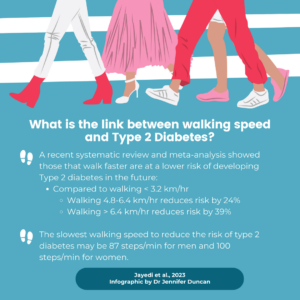This blog is based on a recently published study exploring the link between walking speed and type 2 diabetes (1).
Why is this study important?
Type 2 diabetes is one of the most common metabolic disorders worldwide. Those with type 2 diabetes are at greater risk of many cancers, cardiovascular disease, and premature death. Currently, there are 537 million adults worldwide with diabetes, and this is predicted to increase to 783 million by 2045.
Walking is a simple and inexpensive type of physical activity and is associated with several social, mental, and physical health benefits. Evidence from previous research suggests that frequent walking is associated with a lower risk of developing type 2 diabetes in the general population. However, it is not clear what level of walking speed is needed to reduce the risk of type 2 diabetes. In addition to the time spent walking, walking speed, defined as the speed at which someone habitually walks, may be an important issue when recommending people to increase their physical activity. Currently, there is no specific instruction for walking speed in current guidelines. Therefore, this study focused on an important issue relevant to patients and practice to assess whether a faster walking speed is associated with a lower risk of developing type 2 diabetes, and, if so, what walking speed is needed to reduce the risk of type 2 diabetes.
How did the study go about this?
To answer this important question, we performed a systematic review and meta-analysis study to collect existing evidence in this field. Since there were several scientific studies that addressed this question, we performed a systematic search in medical databases to find cohort studies that investigated the association between walking speed and the risk of type 2 diabetes. Then, we combined the results of the scientific studies to summarise findings and generate a scientific conclusion on the association between walking speed and the risk of type 2 diabetes.
What did the study find?
Our study indicated that people who walk faster are at a lower risk of developing type 2 diabetes in the future. We found that, as compared to those who walk at <3.2 km/hour, those who walk at 3.2-4.8 km/hour, 4.8-6.4 km/hour, and >6.4 km/hour had a 15%, 24%, and 39% lower risk of developing type 2 diabetes, respectively. We found that the slowest walking speed to reduce the risk of type 2 diabetes was 4 km/hour, which is equal to 87 steps/min for men and 100 steps/min for women. Walking at speeds faster than 4 km/hour was proportionally associated with a lower risk.
What are the key take-home points?
While current strategies to increase total walking time are beneficial, it may also be reasonable to encourage people to walk at faster speeds to further increase the health benefits of walking. The slowest walking speed to reduce the risk of type 2 diabetes may be 87 steps/min for men and 100 steps/min for women.

References:
(1) Jayedi A, Zargar M, Emadi A, et al Walking speed and the risk of type 2 diabetes: a systematic review and meta-analysis British Journal of Sports Medicine Published Online First: 28 November 2023. doi: 10.1136/bjsports-2023-107336
Blog authors:
Dr Ahmad Jayedi & Dr Dagfinn Aune